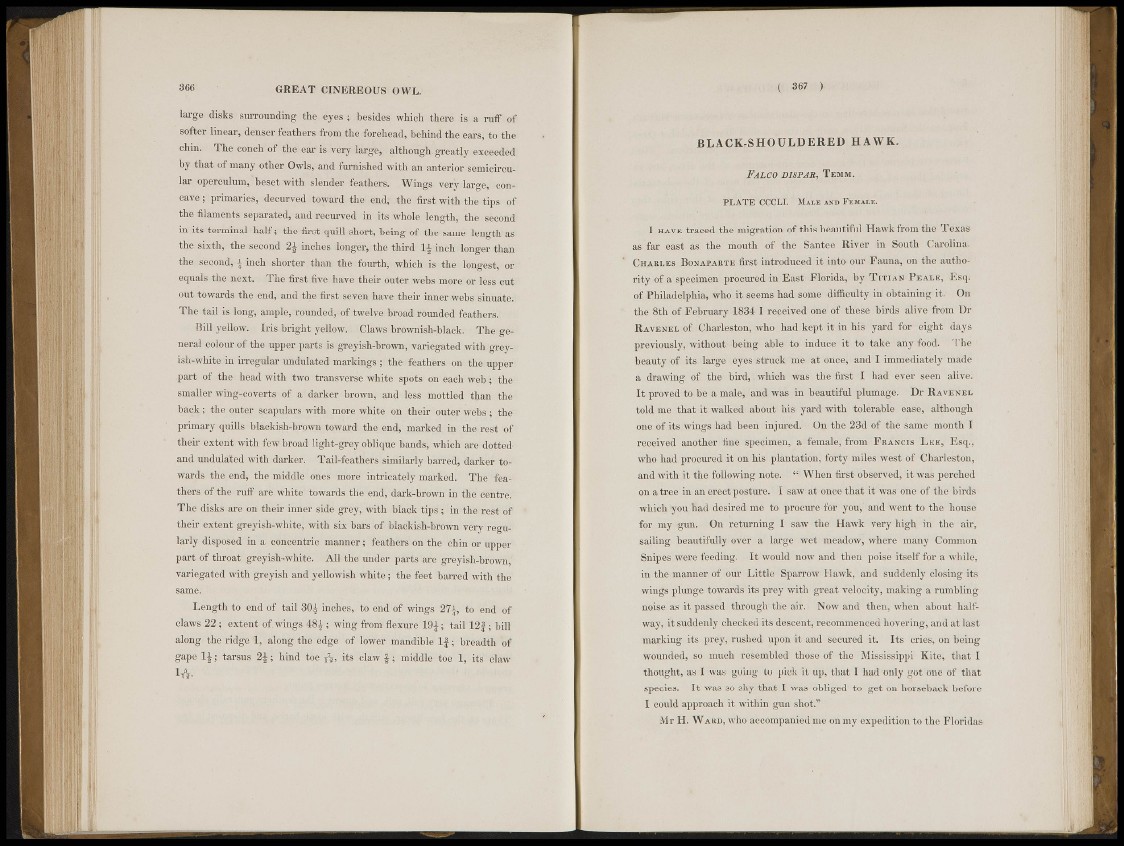
366 GREAT CINEREOUS OWL.
large- disks surrounding the eves ; besides which there is a ruff of
softer linear,. denser feathers from the forehead, behind thSears, to the
(Shin., The conch of the ear is very large, although!greatly Wceeded
by that of many other Owls, and furnished with an anterior somicircular
operculum,'"beset with slender feathers. Wings- very-largejflteml'avw;
i primaries, decurved toward the end, the first with the tips of
the filaments separated, and recurved in its whole length, the second
in its terminal half; the first quill short, being of the same length' as
the sixth, the second 2J- inches .longer, (lie third 1J inch longer than
tho. second, ' inch shorter than the fourth, which is the longest, or
e%iate the next. The first five have, their outer nebs more or less cut
"lit towards the end, and the first seven have their inner webs sinuate.
The tail is long, anipI<yround(-d,.oi twelve broad rounded feathers.' 1
Bill yellow. Iris bright yellow.. Claws brownMi-Mnck. The general
colour of the upper parts is greyish-brown, variegated with grevish
white in irregular undulated markings ;'>the. feathers on the?tipper'
part of the head with two transverse white spots: on each web ; the
smaller wing-coverts of a darker brown, and loss mottled than the
back; the outer scapulars with more white on their outer wvbs; the
primary quills blackish-brpwa toward the ;ends
; marked in tho-.rost of
their extent wilWcw broad light gro\ oblique bands, which are dotted
and undulated with darker. Tail-leathers similarly barred, darker towards
tho end, the middle ones more intricately marked'»* The'^leathors
of the ruff are white towards the end, dark-brown in the contre.
The disks are on their SiilSr side grey, with black tips ; in the rest of
their extent greyish white, with six bars of binckiih-l.rowti very:rognlarly
disposed in a concentric manner - feathers on the chin or upper
part of tilroat Jgre.y isli-whito. All the under parts are greyish-brown,
variegated with greyish and yellowish white?; the:feet barred with the
same.
r.ength itjilRfnd of tall 30 i inches,, to end of wings 27], to end of
claws:22Ppxteni«of.wings; wing from flexure 19J; tail 12J; bill
along the ridge 1» along the edge of lower mandible I f ; breadth of
gape 1J; tarsus 2J; hind toe t
7i-. its claw j ; middle too 1, its claw
I B H I
( 367 )
B L A C K - S H O U L D E R E D HAWK.
FALCO DISPAR, TEMM.
PLAIE CCCLI MAI.® IIFFI FÉMAIÏ.
I H A v K traced the migration of this beautiful Hawk from the Texas
as far east as the mouth of the Santés Hiver in South Carolina.
' CHAULES BONAPAETE: first introduced it into our Fauna, on the author
rity of a specimen procured in East Florida, by TITIÍS 1'JKAI.K, Esq.
of Philadelphia, who it seems had some difficulty in obtaining it.. On
' the 8th of February 1834 I received one of these birds alive from Dr
RAVENEL|M .Charleston, who had kept it in his yard for eight days
previously, without being able to induce it to take arty food. Thé
beauty of its large eyes struck irie at once, and I immediately made
a drawing | | | the bird,. which was the first I had ever seen alive;
It proved to lie a male, and was in beautiful plumage. Dr RAVENEL
told me that it walked about his yard with tolerable ease, although
one of its wings' had buen injured. On the 23d of the same month I
received another fine specimen, a female; from FRANCIS LEE, Esq.,
who had procured it on his plantation, forty niilos west of Charleston,
and with :it the following note. " When first observed; it was perehed
on a tree in an eréct posture. I saw at: Once that it was one of the birds
which you had desired me to procure for you,' and went to tho house
for my gun. On returning I saw the Hawk very high in the air,
sailing beautifully oyer a large wet meadow, where many Common.
• • JSnipos were feeding. It would now and then poise itself for a while,
in the-manner of our Little Sparrow Hawk, and suddenly closing its
wings plunge towards its prey with great velocity, making a rumbling
noise as it passed through the air. Now and then, when about halfway,
it suddenly checked its descent, recommenced hovering, and at last
marking ils1 prey, rushed upon it and secured it. Its cries, on being
wounded, So much resembled those 6t the Mississippi Kite, that I
thought, as I was going to pick it up, that I had only got one of that
species. It was fjf shy that I was obliged to get dm horseback before
I could approach it within gun shot."
Mr H. WARD, who accompanied me on my expedition to the Floridas